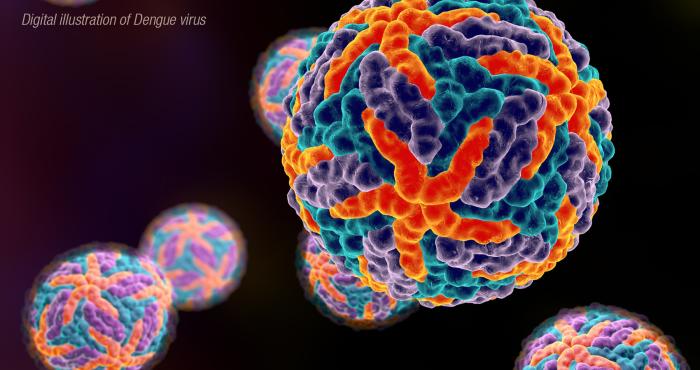UTMB researchers have discovered a new antiviral mechanism for dengue therapeutics

Digital illustration of dengue virus Credit: The University of Texas Medical Branch
Dengue virus is a very important mosquito-transmitted viral pathogen, causing 390 million human infections each year. Dengue is common in more than 100 countries and forty percent of the world's population is at risk of infection.
When someone becomes ill with dengue, symptoms that can range from mild to severe may include fever, nausea/vomiting, rash and muscle/bone/joint aches. Despite this, there are no clinically approved drugs currently available to people who become infected.
In this study, the UTMB team has solved the co-crystal structure of the dengue capsid protein, which forms the interior of virus, in complex with an inhibitor.
The co-crystal structure has provided atomic details of how the inhibitor binds the capsid protein and blocks its normal function, leading to the inhibition of viral infection. The structural information has opened new avenues to rationally design inhibitors for antiviral development.
“There are four types of dengue virus, all of which can cause epidemics and disease in humans. The current inhibitor does not inhibit all types of dengue virus. Our co-crystal structure explains why this is the case,” said Pei-Yong Shi, I.H. Kempner professor of Human Genetics at UTMB.
“Using this new information, we will be able to design new drugs that can inhibit all types of dengue virus. In addition, the structural information will also enable us to make compounds with improved potency and drug-like properties.”
“The inhibitor binds four capsid molecules to form a tetramer. Such capsid tetramers are assembled into dengue virus,” said Mark White, Associate Professor at UTMB who co-senior authored the study.
“However, such a tetramer-containing virus is not able to productively infect new cells. Our study also explains how resistance emerges when dengue virus is treated with the inhibitor. A resistant virus emerges through one amino acid change that weakens the compound binding to the viral capsid protein.”
“The World Health Organization lists dengue virus as one of the top ten public health threats and as such requires the urgent development of effective vaccine and therapeutics,” said Hongjie Xia, UTMB postdoctoral fellow and lead author of the study.
“Although we are currently coping with COVID-19 pandemic, Singapore and other regions are experiencing a record number of dengue human cases. This motivates our team to develop clinical treatments for this devasting disease.”
###
Other authors include UTMB's Xuping Xie, Jing Zou, William Russell, Luis Marcelo Holthauzen and Kyung Choi.
To develop antiviral drugs, the UTMB team has received grants from National Institutes of Health and philanthropic support from the Sealy & Smith Foundation; Robert J. Kleberg, Jr. and Helen C. Kleberg Foundation; John S. Dunn Foundation; Amon G. Carter Foundation; Gillson Longenbaugh Foundation; Summerfield G. Roberts Foundation.
Media Contact
All latest news from the category: Health and Medicine
This subject area encompasses research and studies in the field of human medicine.
Among the wide-ranging list of topics covered here are anesthesiology, anatomy, surgery, human genetics, hygiene and environmental medicine, internal medicine, neurology, pharmacology, physiology, urology and dental medicine.
Newest articles

First-of-its-kind study uses remote sensing to monitor plastic debris in rivers and lakes
Remote sensing creates a cost-effective solution to monitoring plastic pollution. A first-of-its-kind study from researchers at the University of Minnesota Twin Cities shows how remote sensing can help monitor and…

Laser-based artificial neuron mimics nerve cell functions at lightning speed
With a processing speed a billion times faster than nature, chip-based laser neuron could help advance AI tasks such as pattern recognition and sequence prediction. Researchers have developed a laser-based…

Optimising the processing of plastic waste
Just one look in the yellow bin reveals a colourful jumble of different types of plastic. However, the purer and more uniform plastic waste is, the easier it is to…



